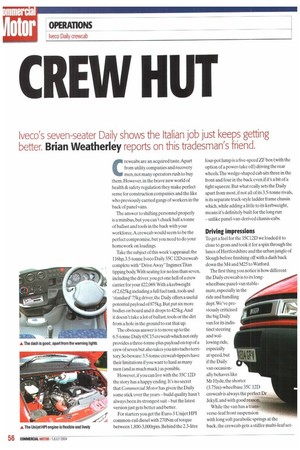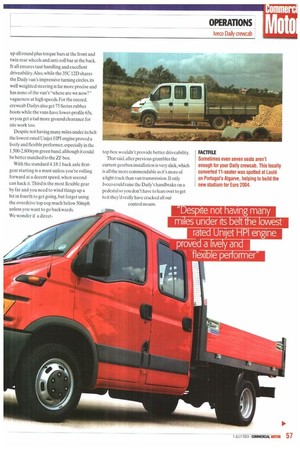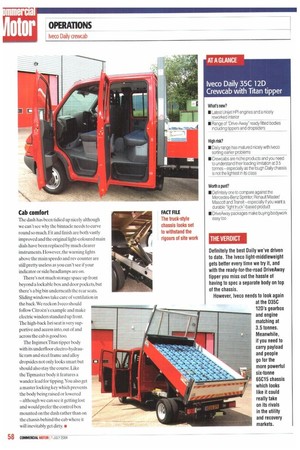CREW HUT
Page 56

Page 57

Page 58

If you've noticed an error in this article please click here to report it so we can fix it.
Iveco's seven-seater Daily shows the Italian job just keeps getting
better. Brian Weatherley reports on this tradesman's friend.
Crewcabs are an acquired taste. Apart from utility companies and recovery men, not many operators rush to buy them. However, in the brave new world of health & safety regulation they make perfect sense for construction companies and the like who previously carried gangs of workers in the back of panel vans.
The answer to shifting personnel properly is a minibus, but you can't chuck half a tonne of ballast and tools in the back with your workforce. A crewcab would seem to be the perfect compromise, but you need to do your homework on loadings.
Take the subject of this week's appraisal: the 116hp,3.5-tonne Iveco Daily 35C 12D crewcab complete with "Drive Away" Ingimex Titan tipping body. With seating for no less than seven, including the driver, you get one hell of a crew carrier for your £22,069. With a kerbweight of 2,625kg including a full fuel tank, tools and 'standard' 75kg driver, the Daily offers a useful potential payload of 875kg. But put six more bodies on board and it drops to 425kg.And it doesn't take a lot of ballast, tools or the dirt from a hole in the ground to eat that up.
The obvious answer is to move up to the 6.5-tonne Daily 65C15 crewcab which not only provides a three-tonne-plus payload on top of a crew of seven but also takes you into tacho territory. So beware: 3.5-tonne crewcab tippers have their limitations if you want to haul as many men (and as much muck) as possible.
However, if you can live with the 35C 12D the story has a happy ending. It's no secret that Commercial Motor has given the Daily some stick over the years build quality hasn't always been its strongest suit but the latest version just gets better and better.
For starters you get the Euro-3 Unijet HP! 24 common-rail diesel with 270Nm of torque between 1,800-3,000rpm. Behind the 23-litre four-pot lump is a five-speed ZF box (with the option of a power-take off) driving the rear wheels.The wedge-shaped cab sits three in the front and four in the back even if it's a bit of a tight squeeze. But what really sets the Daily apart from most, if not all of its 3.5-tonne rivals, is its separate truck-style ladder frame chassis which, while adding a little to its kerbweight, means it's definitely built for the long run unlike panel-van-derived chassis-cabs.
Driving impressions To get a feel for the 35C12D we loaded it to close to gross and took it for a spin through the lanes of Hertfordshire and the urban jungle of Slough before finishing off with a dash back down the M4 and M25 to Watford.
The first thing you notice is how different the Daily crewcab is to its longwheelbase panel-van stablemate, especially in the ride and handling dept.We've previously criticised the big Daily van for its indistinct steering and wallowing ride, especially at speed, but if the Daily van occasionally behaves like Mr Hyde, the shorter (3.75m)-wheelbase 35C 12D crewcab is always the perfect Dr Jekyll, and with good r While the van has a tr verse-leaf front suspension with long soft parabolic springs at the back, the crewcab gets a stiffer multi-leaf set up all round plus torque bars at the front and twin rear wheels and anti-roll bar at the back. It all ensures taut handling and excellent driveability Also, while the 35C 12D shares the Daily van's impressive turning circles, its well weighted steering is far more precise and has none of the van's where are we now?" vagueness at high speeds. For the record. crewcab Dailys also get 75 Series rubber boots while the vans have lower-profile 65s, so you get a tad more ground clearance for site work too.
Despite not having many miles under its belt the lowest rated Unijet HPI engine proved a lively and flexible performer, especially in the 1.500-2,800rpm green band, although it could be better matched to the ZF box.
With the standard 4.18:1 back axle firstgear starting is a must unless you're rolling forward at a decent speed. when second can hack it.Third is the most flexible gear by far and you need to wind things up a bit in fourth to get going, but forget using the overdrive top cog much below 50mph unless you want to go backwards. We wonder if a direct top box wouldn't provide better drive ability.
That said. after previous grumbles the current gearbox installation is very slick, which is all the more commendable as it's more of a light truck than van transmission. If only Iveco could raise the Daily's handbrake on a pedestal so you don't have to lean over to get to it they'd really have cracked all our control moans.
Cab comfort The dash has been tidied up nicely although we can't see why the binnacle needs to curve round so much. Fit and finish are both vastly improved and the original light-coloured main dials have been replaced by much clearer instruments. However,the warning lights above the main speedo and rev counter are still pretty useless as you can't see if your indicator or side/headlamps are on.
There's not much storage space up front beyond a lockable box and door pockets, but there's a big bin underneath the rear seats. Sliding windows take care of ventilation in the back.We reckon Iveco should follow Citroen's example and make electric winders standard up front. The high-back Isri seat is very supportive and access into, out of and across the cab is good too.
The IngimexTrtan tipper body with its underfloor electro-hydraulic ram and steel frame and alloy dropsides not only looks smart but should also stay the course. Like the Tipmaster body it features a wander lead for tipping. You also get a master locking key which prevents the body being raised or lowered — although we can see it getting lost and would prefer the control box mounted on the dash rather than on the chassis behind the cab where it will inevitably get dirty. •


































































































































































































